Determinants of Odor-Related Perception: Analysis of Community Response
Abstract
1. Introduction
2. Materials and Methods
2.1. Community Survey
2.1.1. Region and Period of Study
2.1.2. Data Set and Sample Size
2.2. Statistical Techniques
2.2.1. Chi-Square Test
2.2.2. Logistic Regression
2.2.3. Quality of the Prediction Model
3. Results
3.1. Sociodemographic Factors
3.2. Perceived Odor and Odor-Related Sources
3.3. Determination of the Odds Ratio for the Explanatory Variables of Odor Perception
4. Discussion
4.1. Influence of Meteorological Conditions
4.2. Source Identification and Proximity
4.3. Role of Explanatory Variables on Odor-Related Annoyance
4.4. Methodological Limitations
5. Conclusions
Supplementary Materials
Author Contributions
Funding
Informed Consent Statement
Data Availability Statement
Acknowledgments
Conflicts of Interest
References
- Bokowa, A.; Diaz, C.; Koziel, J.A.; McGinley, M.; Barclay, J.; Schauberger, G.; Guillot, J.M.; Sneath, R.; Capelli, L.; Zorich, V.; et al. Summary and overview of the odour regulations worldwide. Atmosphere 2021, 12, 206. [Google Scholar] [CrossRef]
- Guadalupe-Fernandez, V.; De Sario, M.; Vecchi, S.; Bauleo, L.; Michelozzi, P.; Davoli, M.; Ancona, C. Industrial odour pollution and human health: A systematic review and meta-analysis. Environ. Health 2021, 20, 108. [Google Scholar] [CrossRef] [PubMed]
- Herz, R.S. The role of odor-evoked memory in psychological and physiological health. Brain Sci. 2016, 6, 22. [Google Scholar] [CrossRef]
- Kurian, S.M.; Naressi, R.G.; Manoel, D.; Barwich, A.S.; Malnic, B.; Saraiva, L.R. Odor coding in the mammalian olfactory epithelium. Cell Tissue Res. 2021, 383, 445–456. [Google Scholar] [CrossRef]
- Piccardo, M.T.; Geretto, M.; Pulliero, A.; Izzotti, A. Odor emissions: A public health concern for health risk perception. Environ. Res. 2022, 204, 112121. [Google Scholar] [CrossRef]
- Zhang, Q.; Ruan, S.; Zhang, R.; Zhashiquzong Wu, W. Odor nuisance, environmental impact and health risk of priority-controlled VOCs generated from three decentralized aerobic biological modes in treating rural perishable waste. Environ. Sci. Pollut. Res. 2025, 32, 11040–11051. [Google Scholar] [CrossRef] [PubMed]
- Sucker, K.; Berresheim, H.; Ramcke-Krüll, H.; Schulze, P.; Brüning, T.; Bünger, J. Approach to characterize a sub-group susceptible to odour annoyance. Chem. Eng. Trans. 2011, 23, 99–104. [Google Scholar] [CrossRef]
- Conti, C.; Guarino, M.; Bacenetti, J. Measurements techniques and models to assess odor annoyance: A review. Environ. Int. 2020, 134, 105261. [Google Scholar] [CrossRef]
- Berglund, B.; Berglund, U.; Lindvall, T. Measurement and control of annoyance. Dev. Toxicol. Environ. Sci. 1987, 15, 29–43. [Google Scholar]
- Van Harreveld, A.P. From odorant formation to odour nuisance: New definitions for discussing a complex process. Water Sci. Technol. 2001, 44, 9–15. [Google Scholar] [CrossRef]
- Lindvall, T.; Radford, E.P. Measurement of annoyance due to exposure to environmental factors: The fourth Karolinska institute symposium on environmental health. Environ. Res. 1973, 6, 1–36. [Google Scholar] [CrossRef] [PubMed]
- World Health Organization—WHO. Life in the 21st century: A Vision for all. In The World Health Report; WHO: Geneva, Switzerland, 1998. [Google Scholar]
- Zhang, Y.; Yang, W.; Schauberger, G.; Wang, J.; Geng, J.; Wang, G.; Meng, J. Determination of dose–response relationship to derive odor impact criteria for a wastewater treatment plant. Atmosphere 2021, 12, 371. [Google Scholar] [CrossRef]
- Blanes-Vidal, V.; Suh, H.; Nadimi, E.S.; Løfstrøm, P.; Ellermann, T.; Andersen, H.V.; Schwartz, J. Residential exposure to outdoor air pollution from livestock operations and perceived annoyance among citizens. Environ. Int. 2012, 40, 44–50. [Google Scholar] [CrossRef]
- Egondi, T.; Kyobutungi, C.; Ng, N.; Muindi, K.; Oti, S.; van de Vijver, S.; Ettarh, R.; Rocklöv, J. Community perceptions of air pollution and related health risks in Nairobi slums. Int. J. Environ. Res. Public Health 2013, 10, 4851–4868. [Google Scholar] [CrossRef] [PubMed]
- Hayes, J.E.; Stevenson, R.J.; Stuetz, R.M. The impact of malodour on communities: A review of assessment techniques. Sci. Total Environ. 2014, 500, 395–407. [Google Scholar] [CrossRef]
- Luginaah, I.N.; Taylor, S.M.; Elliott, S.J.; Eyles, J.D. Community reappraisal of the perceived health effects of a petroleum refinery. Soc. Sci. Med. 2002, 55, 47–61. [Google Scholar] [CrossRef]
- Claeson, A.S.; Lidén, E.; Nordin, M.; Nordin, S. The role of perceived pollution and health risk perception in annoyance and health symptoms: A population-based study of odorous air pollution. Int. Arch. Occup. Environ. Health 2013, 86, 367–374. [Google Scholar] [CrossRef]
- Hayes, J.E.; Stevenson, R.J.; Stuetz, R.M. Survey of the effect of odour impact on communities. J. Environ. Manag. 2017, 204, 349–354. [Google Scholar] [CrossRef]
- Santos, J.M.; Reis, N.C., Jr.; Galvão, E.S.; Silveira, A.; Goulart, E.V.; Lima, A.T. Source apportionment of settleable particles in a mining-impacted urban and industrialized region in Brazil. Environ. Sci. Pollut. Res. 2017, 24, 22026–22039. [Google Scholar] [CrossRef]
- Monticelli, D.F.; Furieri, B.; Lavor, V.F.; Goulart, E.V.; Santos, J.M.; Reis, N.C., Jr.; Galvão, E.S.; Lopes, E.; Melo, M.M. Odorous compounds emissions in an urban and industrialized area. In Proceedings of the OLORES19 Conference, Santiago, Chile, 6–9 October 2020. [Google Scholar]
- World Meteorological Organization (WMO). Guide to Instruments and Methods of Observation (WMO-No. 8); Volume I—Measurement of Meteorological Variables; World Meteorological Organization (WMO): Geneva, Switzerland, 2021. [Google Scholar]
- Machado, M.; Santos, J.M.; Reisen, V.A.; Reis, N.C.; Mavroidis, I.; Lima, A.T. A new methodology to derive settleable particulate matter guidelines to assist policymakers on reducing public nuisance. Atmos. Environ. 2018, 182, 242–251. [Google Scholar] [CrossRef]
- Cochran, W.G. Sampling Techniques, 3rd ed.; Wiley: New York, NY, USA, 1977; ISBN 047116240X. [Google Scholar]
- Morettin, P.A.; Bussab, W.O. Estatística Básica, 6th ed.; Editora Saraiva: São Paulo, Brazil, 2010. [Google Scholar]
- Barnett, V. Sample Survey: Principles and Methods, 3rd ed.; Wiley: Chichester, UK, 2002; ISBN 9780470685907. [Google Scholar]
- Rotko, T.; Oglesby, L.; Künzli, N.; Carrer, P.; Nieuwenhuijsen, M.J.; Jantunen, M. Determinants of perceived air pollution annoyance and association between annoyance scores and air pollution (PM2. 5, NO2) concentrations in the European EXPOLIS study. Atmos. Environ. 2002, 36, 4593–4602. [Google Scholar] [CrossRef]
- Wroniszewska, A.; Zwoździak, J. Odor annoyance assessment by using logistic regression on an example of the municipal sector. Sustainability 2020, 12, 6102. [Google Scholar] [CrossRef]
- Agresti, A. An introduction to Categorical Data Analysis, 2nd ed.; Wiley: New York, NY, USA, 2007. [Google Scholar]
- Abraham, B.; Ledolter, J. Introduction to Regression Modeling; Thomson Brooks/Cole: New Jersey, NJ, USA, 2006. [Google Scholar]
- Hosmer, D.W., Jr.; Lemeshow, S.; Sturdivant, R.X. Applied Logistic Regression; John Wiley & Sons: New Jersey, NJ, USA, 2013. [Google Scholar] [CrossRef]
- Baxter, L.; Finch, S.; Lipfert, F.; Yu, Q. Comparing estimates of the effects of air pollution on human mortality obtained using different regression methodologies. Risk Anal. 1997, 17, 273–278. [Google Scholar] [CrossRef] [PubMed]
- McHugh, M.L. The odds ratio: Calculation, usage, and interpretation. Biochem. Medica 2009, 19, 120–126. [Google Scholar] [CrossRef]
- Domínguez-Almendros, S.; Benítez-Parejo, N.; Gonzalez-Ramirez, A.R. Logistic regression models. Allergol. Immunopathol. 2011, 39, 295–305. [Google Scholar] [CrossRef]
- Rudke, A.P.; De Almeida, D.S.; Alves, R.A.; Beal, A.; Martins, L.D.; Martins, J.A.; Hallak, R.; Albuquerque, T.T.A. Impacts of strategic mobility restrictions policies during 2020 COVID-19 outbreak on Brazil’s regional air quality. Aerosol Air Qual. Res. 2022, 22, 210351. [Google Scholar] [CrossRef]
- Kuhn, M.; Johnson, K. Applied Predictive Modeling; Springer: New York, NY, USA, 2013. [Google Scholar]
- Machado, M.; Santos, J.M.; Reisen, V.A.; Silva, A.F.P.; Reis, N.C., Jr.; Bondon, P.; Mavroidis, I.; Prezotti Filho, P.R.; Frere, S.; Lima, A.T. Parameters influencing population annoyance pertaining to air pollution. J. Environ. Manag. 2022, 323, 115955. [Google Scholar] [CrossRef]
- Machado, M.; Santos, J.M.; Frere, S.; Chagnon, P.; Reisen, V.A.; Bondon, P.; Ispány, M.; Mavroidis, I.; Reis, N.C., Jr. Deconstruction of annoyance due to air pollution by multiple correspondence analyses. Environ. Sci. Pollut. Res. 2021, 28, 47904–47920. [Google Scholar] [CrossRef]
- Wojnarowska, M.; Plichta, G.; Sagan, A.; Plichta, J.; Stobiecka, J.; Sołtysik, M. Odour nuisance and urban residents’ quality of life: A case study in Kraków’s in Plaszow district. Urban Clim. 2020, 34, 100704. [Google Scholar] [CrossRef]
- Blanes-Vidal, V. Air pollution from biodegradable wastes and non-specific health symptoms among residents: Direct or annoyance-mediated associations? Chemosphere 2015, 120, 371–377. [Google Scholar] [CrossRef] [PubMed]
- Orru, K.; Nordin, S.; Harzia, H.; Orru, H. The role of perceived air pollution and health risk perception in health symptoms and disease: A population-based study combined with modelled levels of PM10. Int. Arch. Occup. Environ. Health 2018, 91, 581–589. [Google Scholar] [CrossRef] [PubMed]
- Axelsson, G.; Stockfelt, L.; Andersson, E.; Gidlof-Gunnarsson, A.; Sallsten, G.; Barregard, L. Annoyance and worry in a petrochemical industrial area—Prevalence, time trends and risk indicators. Int. J. Environ. Res. Public Health 2013, 10, 1418–1438. [Google Scholar] [CrossRef] [PubMed]
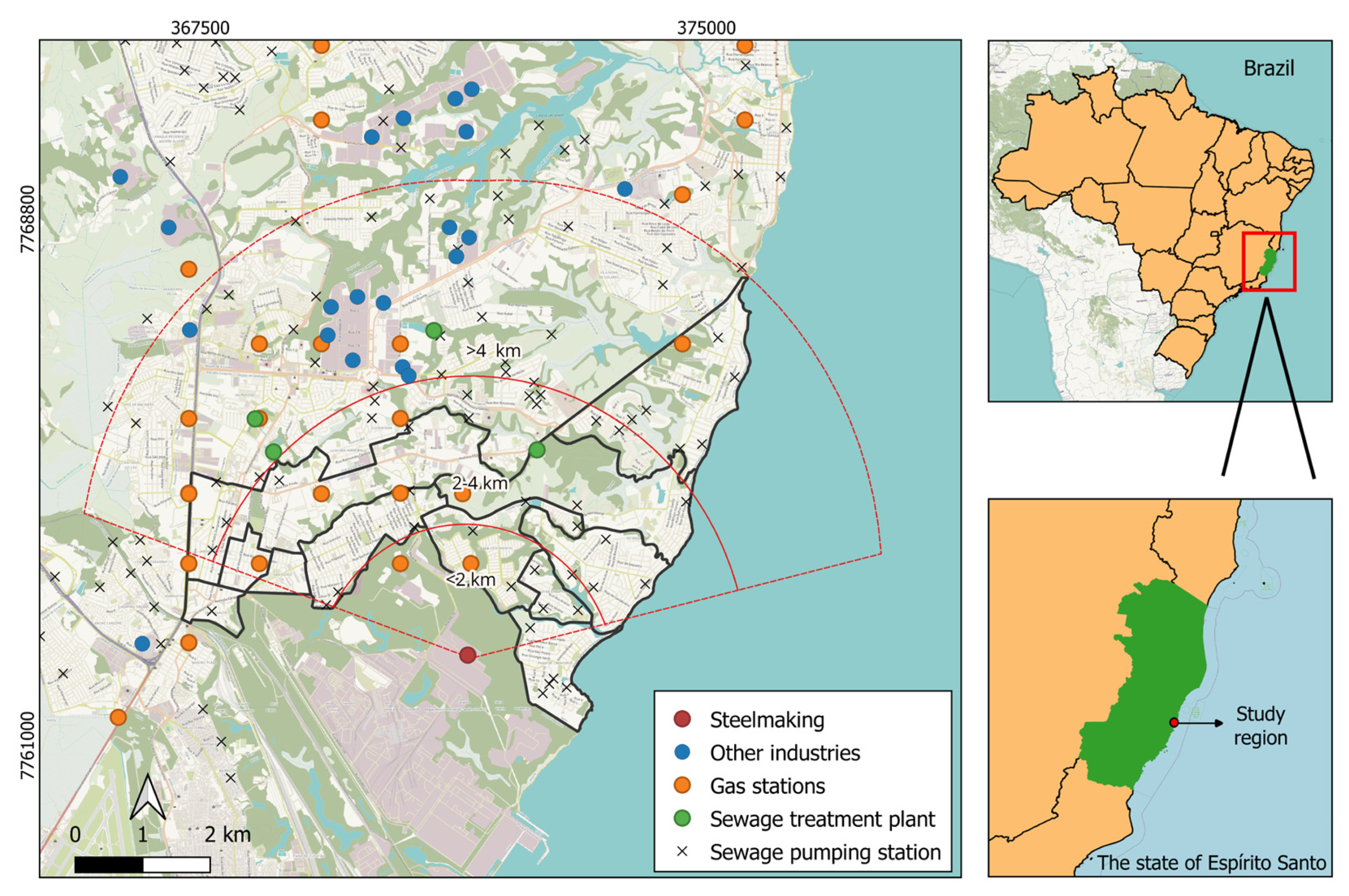

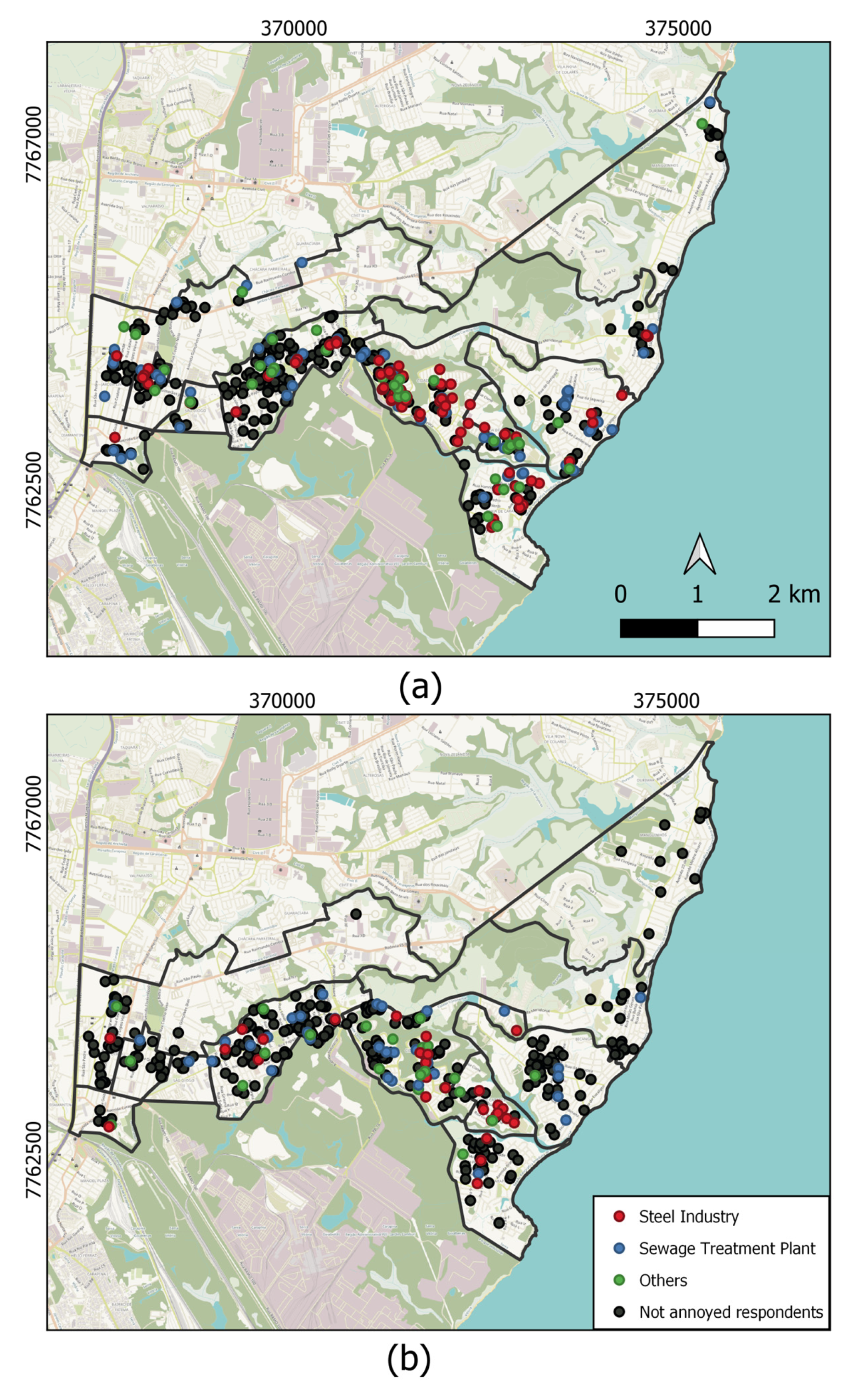
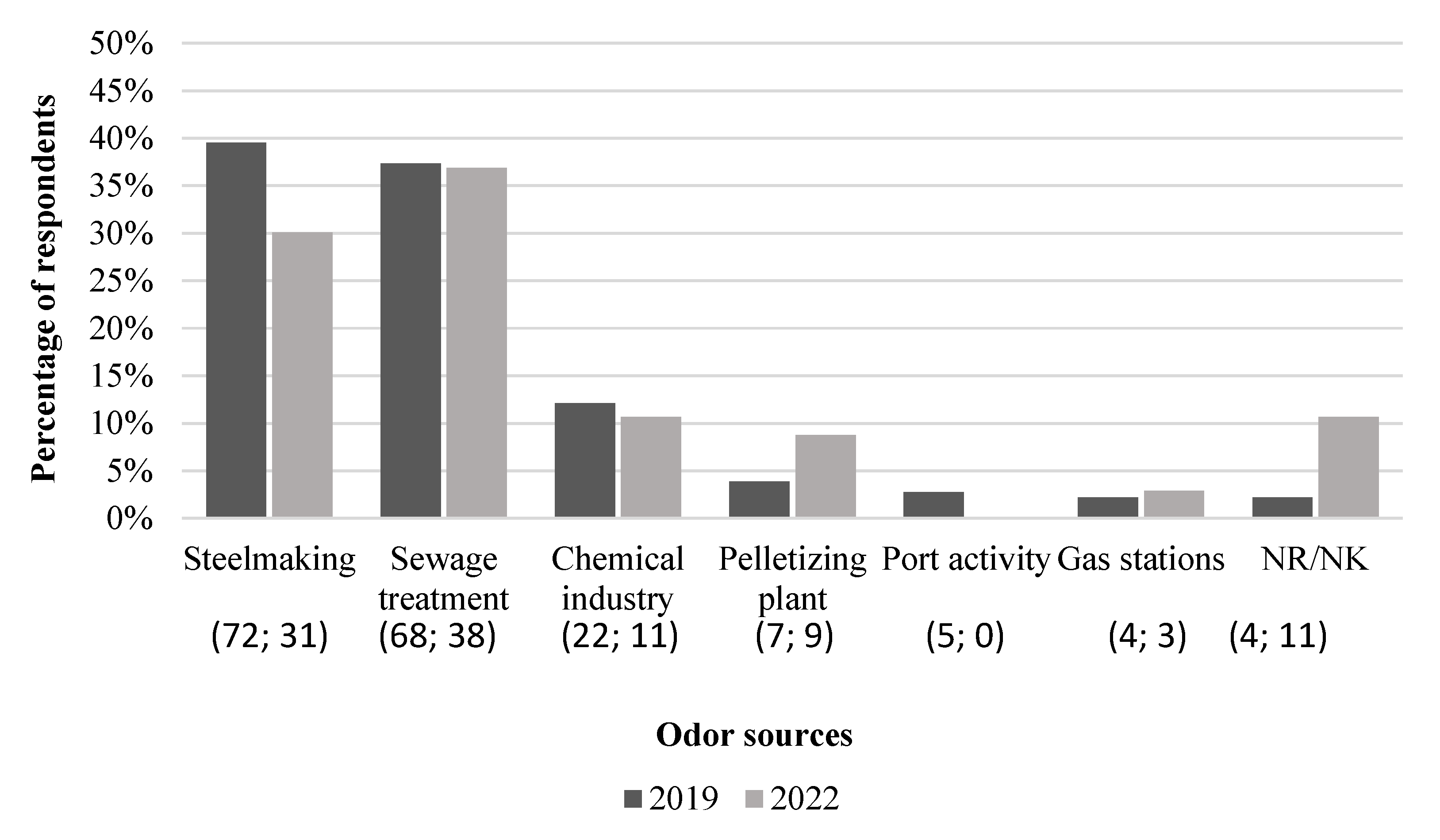
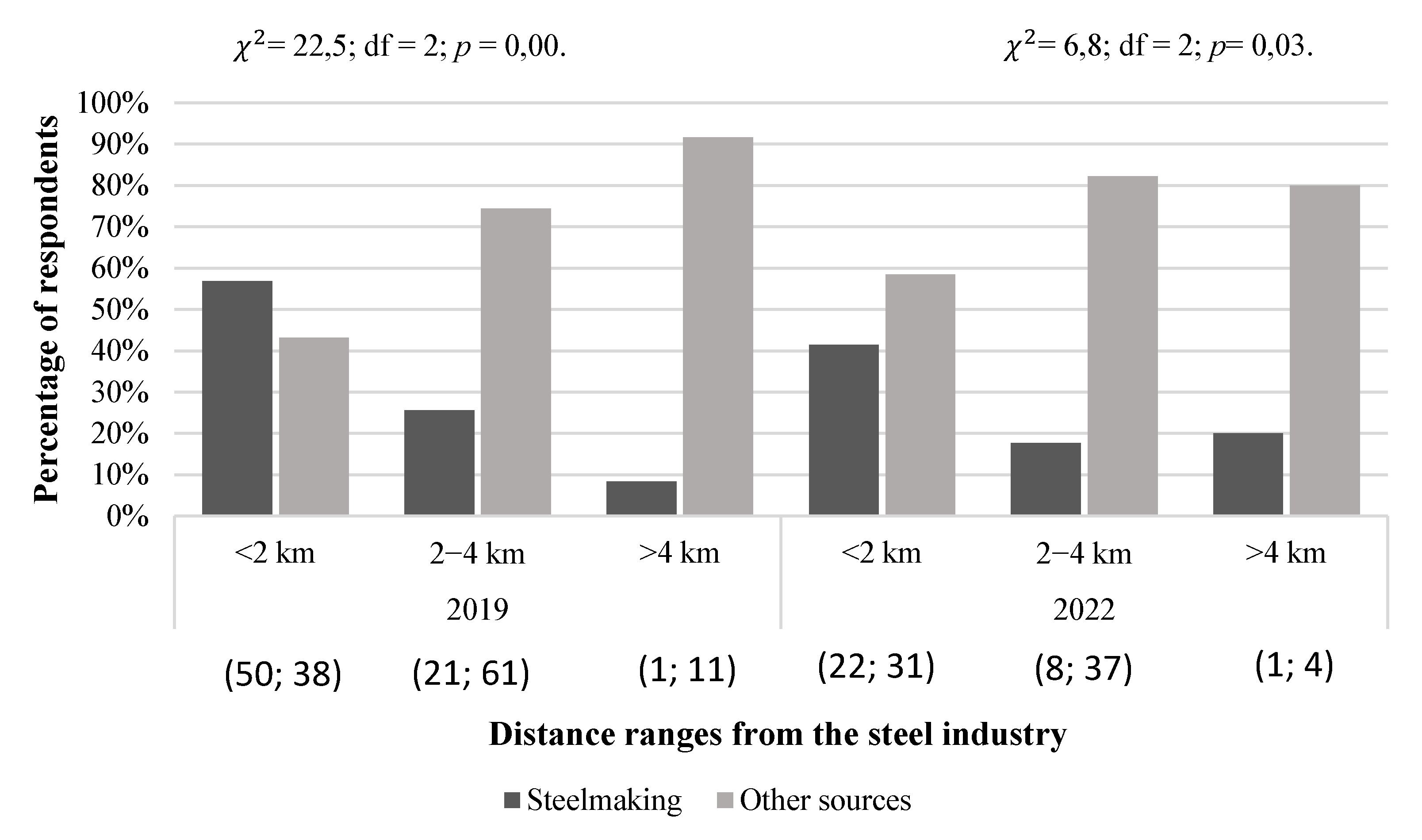
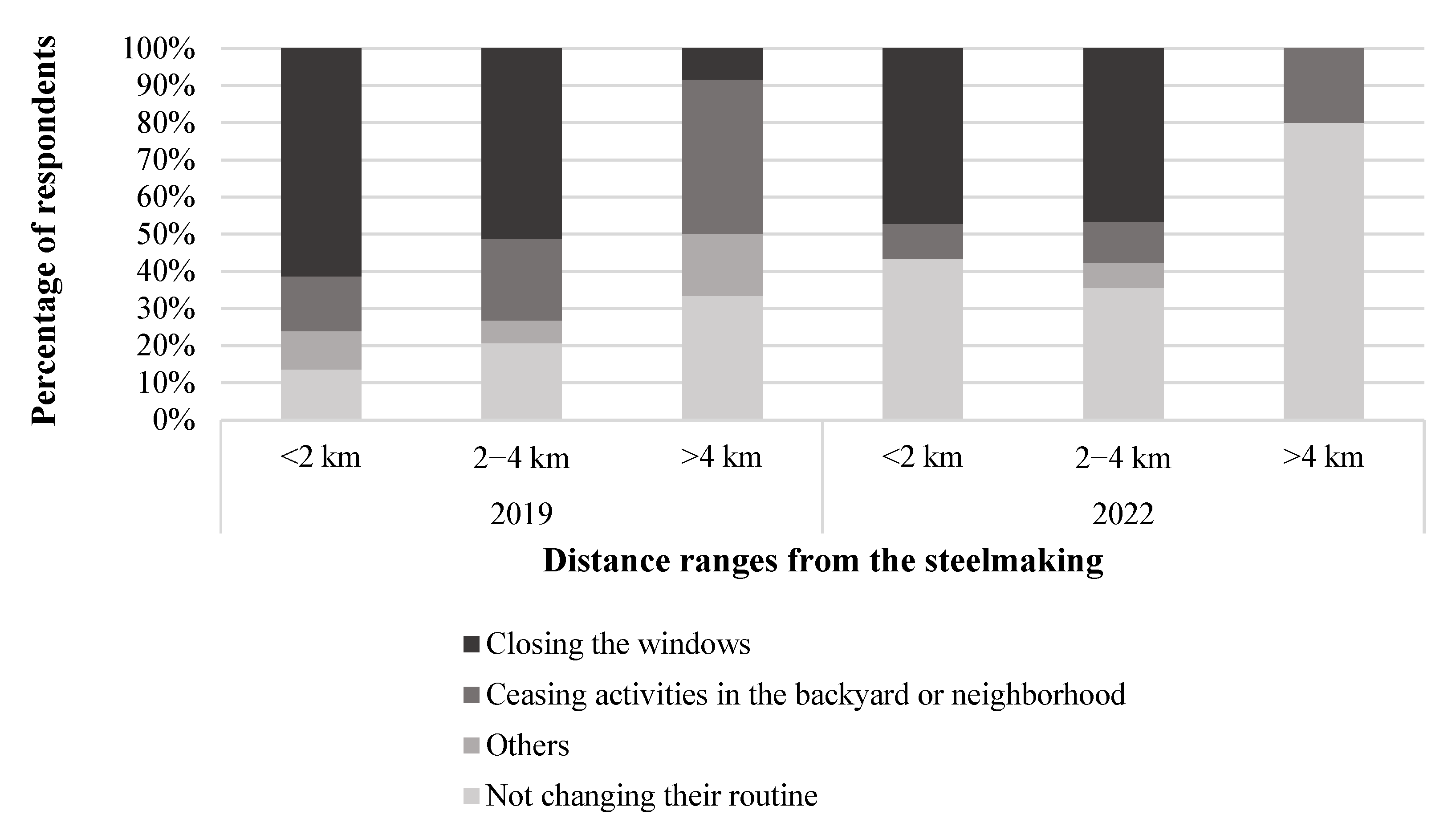
| Variable | Type | Coding |
|---|---|---|
| More than two years of residence | Binary | 0 = no; 1 = yes. |
| Air pollution is the most disliked aspect of the region | ||
| Air pollution is the most concerning issue | ||
| Air pollution perceived through dust accumulation | ||
| Air pollution perceived through reduced visibility | ||
| Odors interfere with daily activities | ||
| Self-reported respiratory problems within the past six months | ||
| Respondent’s gender: female | ||
| Being a smoker | ||
| Frequency of occurrence of solvent smell | Ordinal scale | 1 = never; 2 = rarely; 3 = sometimes; 4 = often; 5 = always. |
| Frequency of occurrence of urine smell | ||
| Frequency of occurrence of sewage smell | ||
| Frequency of occurrence of plastic or burned asphalt smell | ||
| Frequency of occurrence of aggressive smell | ||
| Perceived odor source | Categorical | 1 = pelletizing, steel, and chemical industries; 2 = sewage treatment plant; 3 = gas stations and others. |
| Characteristics of the perceived odor | 1 = solvent, burned asphalt, and aggressive plastic; 2 = urine and sewage; 3 = others. | |
| Professional occupation | 1 = employee; 2 = unemployed; 3 = retired; 4 = student; 5 = self-employed; 6 = homemaker. | |
| Age group | 1 = 16–24 years; 2 = 25–44 years; 3 = 45–64 years; 4 = ≥65 years. | |
| Schooling level | 1 = no formal education; 2 = elementary school; 3 = high/secondary; 4 = higher education. |
| Profile | 2019 (n = 505) | 2022 (n = 400) | ||||
|---|---|---|---|---|---|---|
| Man | Woman | Total | Man | Woman | Total | |
| Professional occupation | ||||||
| Employed | 38 | 40 | 39 | 33 | 29 | 31 |
| Unemployed | 6 | 7 | 6 | 10 | 15 | 13 |
| Retired | 21 | 12 | 16 | 22 | 7 | 14 |
| Student | 4 | 3 | 4 | 9 | 9 | 9 |
| Self-employed | 31 | 23 | 27 | 25 | 26 | 25 |
| Homemaker | 0 | 14 | 8 | 0 | 14 | 7 |
| Declined to answer | 0 | 1 | 0 | 1 | 0 | 1 |
| Age | ||||||
| 16–24 years | 12 | 20 | 16 | 24 | 16 | 20 |
| 25–44 years | 33 | 42 | 38 | 26 | 42 | 34 |
| 45–64 years | 38 | 29 | 33 | 34 | 37 | 36 |
| ≥65 years | 15 | 7 | 11 | 16 | 5 | 10 |
| Declined to answer | 2 | 2 | 2 | 0 | 0 | 0 |
| Education level | ||||||
| No formal education | 4 | 3 | 4 | 1 | 2 | 2 |
| Elementary/primary school | 25 | 22 | 23 | 22 | 25 | 234 |
| High/secondary school | 53 | 55 | 54 | 61 | 46 | 53 |
| Higher education | 15 | 19 | 17 | 16 | 27 | 212 |
| Declined to answer | 3 | 1 | 2 | 1 | 0 | 1 |
| Survey | Slightly Annoyed Scale 1 to 6 | Very Annoyed Scale 7 to 10 | Total of Annoyed Individuals | Total of Survey’s Participants |
|---|---|---|---|---|
| 2019 | 34 (7%) | 148 (29%) | 182 (36%) | 505 (100%) |
| 2022 | 25 (6%) | 78 (20%) | 103 (26%) | 400 (100%) |
| Survey | Variables | p-Value | OR | CI | |
|---|---|---|---|---|---|
| 2019 | Air pollution perceived through dust accumulation | 3.35 | 0.07 | 2.78 | 1.0–11.3 |
| Air pollution perceived through reduced visibility | 4.33 | 0.04 | 1.73 | 1.0–4.0 | |
| Female gender | 9.27 | 0.01 | 2.88 | 1.3–6.9 | |
| Self-reported respiratory problems | 3.69 | 0.05 | 1.82 | 1.0–4.5 | |
| 2022 | Frequency of occurrence of sewage smell | 12.22 | 0.02 | 1.32 | 1.0–2.0 |
| Age group | 6.09 | 0.11 | 0.84 | 0.4–1.7 | |
| Self-reported respiratory problems | 6.45 | 0.01 | 3.37 | 1.2–9.8 |
| Observed | Prediction | |||
|---|---|---|---|---|
| Slightly Annoyed (0) | Very Annoyed (1) | Percentage of Correct Answers | ||
| 2019 | Slightly annoyed (0) | 29 (TN) | 2 (FP) | 93.5% |
| Very annoyed (1) | 3 (FN) | 135 (TP) | 97.8% | |
| Overall percentage | 97% | |||
| 2022 | Slightly annoyed (0) | 20 (TN) | 2 (FP) | 90.9% |
| Very annoyed (1) | 4 (FN) | 66 (TP) | 94.3% | |
| Overall percentage | 93.5% | |||
Disclaimer/Publisher’s Note: The statements, opinions and data contained in all publications are solely those of the individual author(s) and contributor(s) and not of MDPI and/or the editor(s). MDPI and/or the editor(s) disclaim responsibility for any injury to people or property resulting from any ideas, methods, instructions or products referred to in the content. |
© 2025 by the authors. Licensee MDPI, Basel, Switzerland. This article is an open access article distributed under the terms and conditions of the Creative Commons Attribution (CC BY) license (https://creativecommons.org/licenses/by/4.0/).
Share and Cite
Cavalcante, F.R.; Machado, M.; Reisen, V.A.; Furieri, B.; Goulart, E.V.; Ponce de Leon, A.; Reis, N.C., Jr.; Frère, S.; Santos, J.M. Determinants of Odor-Related Perception: Analysis of Community Response. Atmosphere 2025, 16, 1176. https://doi.org/10.3390/atmos16101176
Cavalcante FR, Machado M, Reisen VA, Furieri B, Goulart EV, Ponce de Leon A, Reis NC Jr., Frère S, Santos JM. Determinants of Odor-Related Perception: Analysis of Community Response. Atmosphere. 2025; 16(10):1176. https://doi.org/10.3390/atmos16101176
Chicago/Turabian StyleCavalcante, Franciele Ribeiro, Milena Machado, Valdério Anselmo Reisen, Bruno Furieri, Elisa Valentim Goulart, Antonio Ponce de Leon, Neyval Costa Reis, Jr., Séverine Frère, and Jane Meri Santos. 2025. "Determinants of Odor-Related Perception: Analysis of Community Response" Atmosphere 16, no. 10: 1176. https://doi.org/10.3390/atmos16101176
APA StyleCavalcante, F. R., Machado, M., Reisen, V. A., Furieri, B., Goulart, E. V., Ponce de Leon, A., Reis, N. C., Jr., Frère, S., & Santos, J. M. (2025). Determinants of Odor-Related Perception: Analysis of Community Response. Atmosphere, 16(10), 1176. https://doi.org/10.3390/atmos16101176






